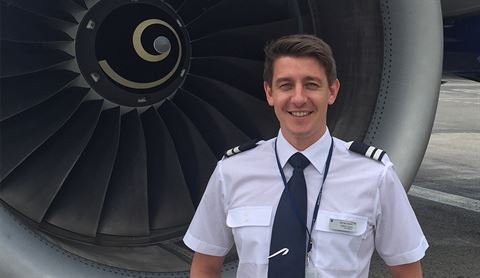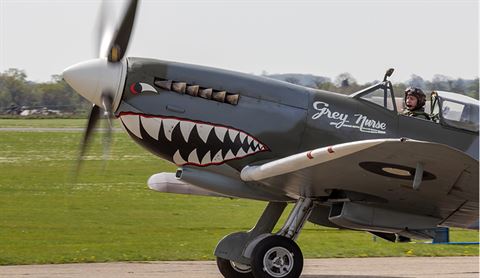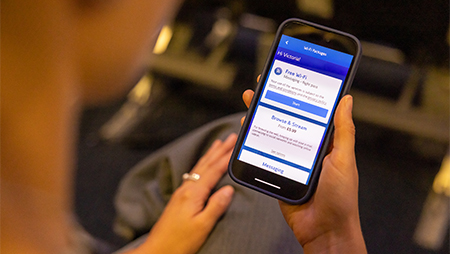May 2024
What's it like to fly a Spitfire?
It’s been 80 years since the historic Normandy Landings, when Spitfires played a major role in protecting Allied forces from attack. Ahead of the D-Day 80 commemorations, we head to Biggin Hill to share notes with British Airways Senior First Officer and Spitfire pilot Adam Lacey
Adam, how did you get your start flying vintage planes?
Having already worked for British Airways for two years at this point, in 2020 I did my Flight Instructor Rating (FIC), with the aim of teaching people tailwheel flying. I knew that to eventually fly Spitfires, I’d need a lot of tailwheel hours under my belt, and teaching was the best – and most rewarding – way to get them. I began instructing at Kemble (Cotswold Airport), now home to BA’s Negus 747. I then joined Duxford in 2021, flying vintage Tiger Moths, the wartime planes pilots would have started off on, and eventually the Harvard – an American World War II trainer and altogether bigger beast. After that, it was on to Chipmunks – a 1950s taildragger.

Adam in his British Airways uniform
What led you to Biggin Hill?
By the end of 2022, I was fortunate enough to be affiliated to many different private flying outlets, but I was still driving toward my lifelong ambition: I wanted to fly the Spitfire. Trouble being, so did all the other pilots around me, many of whom had similar experience and flying hours to me. Having approached Biggin Hill, the only vacancy was for ground staff. I knew I’d be spending those days sweeping the hangar, not flying, and with no gurantee of ever making close to the Spitfire. Still, I knew this was the right environment for me, and I gave it a shot.
How do you go from sweeping the floors to flying the Spitfire?
With a lot of patience! I gave it a couple of months doing my duties (which, glamorously, involved cleaning the loos), before I asked to take on some more customer-facing roles: strapping passengers in, refuelling the aircraft, that kind of thing. I was more than happy to do this unpaid if it meant getting closer to the aircraft. That summer, they started running experience flights from Kemble, my old stomping ground, and I was all set to help out with the first flight there. What I didn’t realise (not until I was emailed a ton of pilot notes, flight reference cards and a tech quiz a few days before), was that I’d be flying in the back of the Spitfire both there and back with a fellow British Airways skipper and experienced Spitfire training pilot.
New chase plane pilots start their training. I’m still furiously sweeping that hangar floor.
What was that first flight like?
As this Spitfire pilot was also a trainer, I was allowed to actually fly the Spitfire, taking off and landing it from the back seat. It was an amazing experience, but I knew this was a test. If I was completely useless, that would be the feedback, and the dream would be dead. Luckily, all went smoothly. However, I was still nowhere near becoming a Spitfire pilot. After a while, an advertisement went out for the chase plane – the pilots who fly out next to the Spitfires, allowing customers to take photographs and the like. Previous chase plane pilots had gone on to fly the Spitfire, so with this in mind, I applied for the role. Fast forward some weeks later, and there were some new chase plane pilots starting their training. Meanwhile, I’m still furiously sweeping that hangar floor.
So when did you become a Spitfire pilot?
One day, I was asked if I’d read the operating manuals for the chase planes. After telling them no, I was asked to spend a couple of hours swotting up and then, a few weeks later, I was asked to do my line training on the chase planes. But still no real job – or promise of one. Another Kemble day came around, and I jumped at the chance to be at the back of the Spitfire again, taking off and landing once more. Finally, on a cold Friday evening in October last year, I was readying to put the plane back in the hangar when I was told, “No, no, get your flight suit on. We’re going flying.” I made for the back seat. “Why are you getting in there?” I was asked. “Get in the front seat.” I was being asked to fly this thing from the front for the first time. We went for a 20-minute blast around the block and after completing my dual check at the beginning of 2024, I’ve been an official Spitfire pilot.
How do you feel about your journey to the Spitfire cockpit, looking back?
A part of me always hoped this is how it would work out but, at times, it wasn’t looking likely. One operator told me I needed 1,000 hours of tailwheel flying – I was miles off that. Then I’d hear a story of another pilot, someone with next to no tailwheel experience, who just got on really well with the owner of an outfit, and I had to wonder how much of this is being in the right place at the right time. I knew Biggin Hill was the right place. I think Peter Monk, owner of the Heritage Hanger, likes someone who’s willing to put in a bit of a graft. I used to be in the RAF and certainly don’t mind getting my hands dirty. Ultimately, I knew it wasn’t about trying to prove myself as some superhuman pilot – it was about biding my time and about doing it safely, professionally, protecting that owner’s asset and delivering an excellent, memorable service to bucket-list-ticking customers.
Does that describe most of the customers you encounter?
I would say so. We’ll meet customers who have a connection to someone who fought and flew aircraft in the war, so there’s often an emotional side there, too. For others, their lives have been cut short with news of terminal illness, and to fly in the Spitfire is their ultimate dream. Inevitably, we’re also flying less and less veterans. One of our pilots had the privilege of taking up a B17 waist gunner who’d been shot down in World War II. He’d tried to escape the plane while it was aflame, bailing out into a field and hiding as German soldiers marched past. I was fortunate enough to have flown him in the Tiger Moth a few days prior. These days, it can feel like the script of a war film, but these people lived and experienced this. It’s fascinating to hear about it all. And, yes, a few people throw up from the flying. But the funny thing is, they always want to continue!
How are the Spitfires different now to back then?
In terms of operating, we’re not going anywhere near to the parameters that they reached during World War II. We’re way back on the power (also to preserve engine life), going up to a maximum three Gs – it’s not a sustainable level of G-force like you’d have had in the dog fights. We go to around 240mph to get the speed we need. Back in the day, they’d have been pushing over 400mph. We stick to a tight rule set even in terms of general behaviour around the aircraft, and prioritise safe, controlled flying. And it’s not just for aircraft preservation but also for our customers. We don’t want scared passengers. Everyone should come away smiling.

Which is your favourite Spitfire?
Peter has a coveted 1943 Spitfire T.9 MJ627, which has invasion stripes on the wings and body to signify its operational combat history, having shot down a German warplane over Europe in 1944. That one is pretty special. But my favourite has to be Sharky. Sharky was part of the No.457 ‘Grey Nurse’ squadron, all of which were painted with a shark’s mouth on the front. That was my first Spitfire, right at the beginning, when I flew in the back seat from Kemble to Biggin Hill.
And, finally, why do you think these planes are so special?
In the warbird world, the Spitfire and the P51 Mustang – those types of planes with the Merlin engines – were the planes. Ultimately the Spitfire is a symbol of victory. Go back 80 years, and the Spitfire is that pinnacle, the top of the tree. The role it played during the Battle of Britain, not to mention its beauty with the elliptical wing and the sound of the V12 27-litre Merlin engine, only scratch the surface as to why this aircraft and many like it are so special. To fly it, though, you have to take it off that pedestal so you’re not daunted by it. To me, there’s nothing in the world quite like flying a Spitfire over the White Cliffs of Dover, an airspace with so much history.
Keep your eyes peeled on the Heritage Hangar’s Facebook page and website for updates on any D-Day 80 activity.
More from previous issues

The joy of solo travel
With Companion Vouchers now providing a discount for solo travellers, friends of The Club share their singleton stories of adventure

A Millennial’s guide to Avios
Silver Member Jordan McGurk has fuelled his epic adventures with Avios – and here’s how you can, too

Our £7bn transformation plan revealed
It’s the investment you’ve all been waiting for: new lounges, a much-improved app, a road map to sustainable fuel, free Wi-Fi and more

Five – actually cool – airport hotels around the world
Say goodbye to airport hotels as you know them. These design-centric stays are shaking things up for the better
